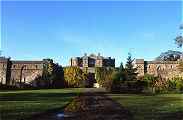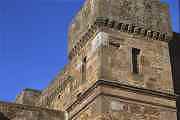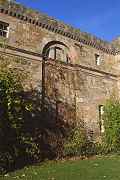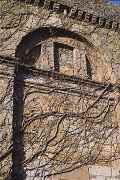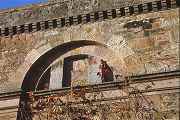|
|||||||||||||||||||||||||||||||||||||||||||||||
|
The entrance courtyard is perhaps one of the most interesting parts of the design for this building. The house is screened from the South by the fortress-like side wings and the convex wall enclosing the courtyard between them with the arched gate placed centrally on the axis of the house. The South side of the house is only revealed once you are through the courtyard gate. What is most immediately striking is that the house looks like a castle keep, with massive square and circular turrets that form the outer walls. There is a great contrast between the massive scale of these elements and the delicacy of the front door screen and the miniature scale of the stone details in the courtyard The front entrance screen is in three parts, with Corinthian pilasters separating the door from casement windows on either side. The pilasters support an entablature, over which is a lunette window within a flattened arch. The window has wonderfully delicate radiating glazing bars and tracery. The shallow arch, flattened as though by the weight of the building over, adds to the impression of the massiveness of the walls of the house. On the South side of the courtyard, what on the outside formed the convex walls on either side of the gate are revealed to be open loggias embracing the space. These terminate in a miniature turret on either side of the entrance gate. There is an insistent symmetry to the composition which determines the plan form of the courtyard. The curve of the wall of the two parts of the loggia on either side of the gate to the courtyard are mirrored by the curved walls on the North side of the courtyard. While it is not immediately apparent what is behind this walls, they take the form of a blind arcades, the arches of which, while they contain windows, also mirror and correspond to the open arches of the loggia opposite. (These walls are actually the outer walls of the corridors on either side linking the service wings to the house). The courtyard is contained to the East and West by the walls of the side wings. Centrally positioned in the West wall of the courtyard is a tripartite Venetian window opening to the kitchen. Opposite on the East wall of the courtyard are corresponding blank windows - the stables would not have merited a window.
At the corners of the curved arcaded corridor connecting the wings to the house are miniature bartizans. As well as being sculptural elements, their function is to terminate the arcades and the arcaded loggia opposite with a visual accent. The bartizan was originally a defensive feature of medieval castles. They allowed defenders a better field of view for firing on an attacking force below, while keeping them protected. Clearly this bartizan, only about 4 feet high, has lost all practical purpose of this sort. It has become an expression of the architectural vocabulary of the Castle Style that Adam is using for this building. Used here it a piece of sculpture, but is not just decorative. To the 18th Century mind these stone details, derived from the vocabulary of medieval castles, would have "meaning", resonating with 18th Centrury concepts of the romanic and picturesque. Beyond this there is also a subtle game being played to amuse us. Because the bartizans and machicolations (small arches under the string course) have been scaled down so dramatically from their "normal" proportions, the visitor is suddenly a giant in this Lilliputian courtyard. Miniature archers might be expected to fire at any minute from behind the miniature parapets in defense of the house. The miniaturisation contrasts with and exaggerates the massive scale of the house itself with its huge turrets ascending above the miniature world. |
|||||||||||||||||||||||||||||||||||||||||||||||
|
|
|||||||||||||||||||||||||||||||||||||||||||||||
|
|
|||||||||||||||||||||||||||||||||||||||||||||||
